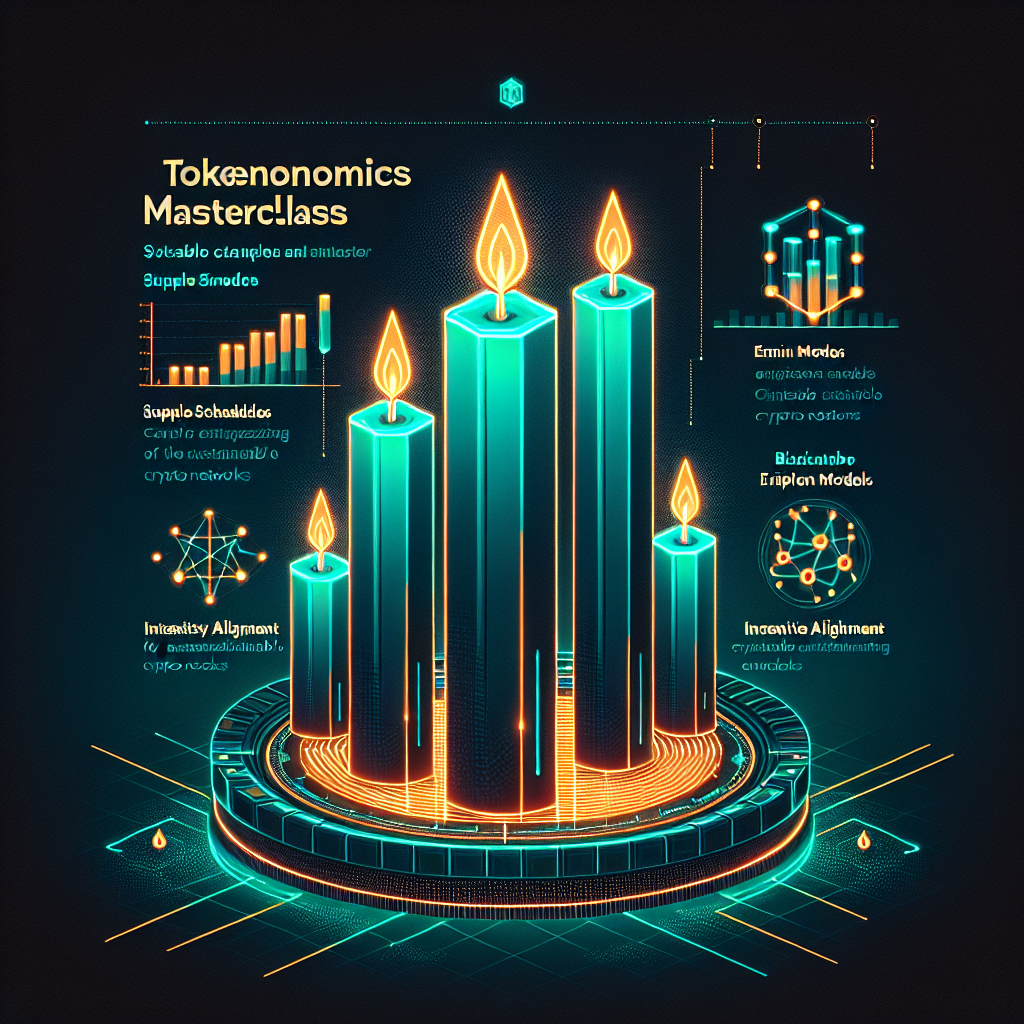Tokenomics Masterclass: Supply Schedules, Emission Models, and Incentive Alignment for Sustainable Crypto Networks

Introduction: Why Tokenomics Matters
In 2024, the difference between a thriving blockchain ecosystem and a forgotten alt-coin often boils down to one factor: tokenomics. A well-designed economic model governs everything from user adoption and network security to long-term price stability. This masterclass unpacks three core pillars—supply schedules, emission models, and incentive alignment—so builders and investors can evaluate whether a crypto network is sustainable or destined to implode.
What Is Tokenomics?
Tokenomics is the study of how a digital asset’s design influences its value and utility within a decentralized network. While whitepapers usually spotlight consensus mechanisms or scalability, tokenomics quietly determines the asset’s economic gravity: how tokens enter circulation, who receives them, and why users should care. Key variables include total supply, initial distribution, inflation or deflation mechanisms, and utility hooks that turn holders into long-term participants.
Supply Schedules: The Foundation of Scarcity
The supply schedule outlines the pace and magnitude of new token issuance. Bitcoin’s fixed cap of 21 million established the gold standard for predictable scarcity, fostering the "digital gold" narrative. By contrast, Ethereum’s dynamic model trades a hard cap for a flexible burn policy via EIP-1559, balancing issuance with network demand. Whether capped or elastic, clarity around supply boosts investor confidence and sets expectations for future dilution.
Fixed Supply Models
A fixed supply model commits to a final token count from day one. Supply is often front-loaded to bootstrap security through block rewards, then dwindles over time via halving or tapering events. This approach attracts holders seeking built-in scarcity but can expose networks to security risks if fees fail to replace shrinking miner or validator rewards.
Elastic and Deflationary Supply
Elastic supply permits protocol adjustments based on governance decisions or algorithmic rules. TerraUSD’s fallen algorithm showed the perils of poorly collateralized elasticity, while EIP-1559 exemplifies a safer hybrid: a burn mechanism that can tip ETH into net deflation when usage is high. Deflationary pressure can bolster price, but excessive burn rates may disincentivize spending, stunting ecosystem growth.
Emission Models: How Tokens Enter Circulation
Even a flawless supply cap falls short if tokens flood the market too quickly. Emission models specify the release cadence and distribution channels, balancing network security, user incentives, and investor sentiment.
Proof of Work (PoW) Emissions
PoW chains mint new coins to reward miners for computational work. Halving cycles, like Bitcoin’s every 210,000 blocks, slow issuance and historically trigger supply shocks that fuel bullish narratives. Yet PoW emissions are energy intensive and may overcompensate miners, diverting value from ecosystem development.
Proof of Stake (PoS) Emissions
PoS replaces energy expenditure with capital risk, paying validators in newly minted tokens or transaction fees. Networks such as Cardano and Solana calibrate staking rewards to maintain a target inflation rate. Adjustable reward curves let governance dial emissions up or down, aligning network security with token velocity.
Liquidity Mining and User Incentives
DeFi protocols popularized liquidity mining, distributing tokens to liquidity providers as a bootstrap mechanic. While yield farming drives rapid adoption, unsustainably high APRs can induce mercenary capital that dumps rewards at first opportunity. A decreasing emissions curve or bonus multiplier for long-term staking can mitigate short-term sell pressure.
Vesting, Cliffs, and Lockups
Founders, early investors, and community treasuries often receive large token allocations. Transparent vesting schedules with cliffs and gradual unlocks reassure retail investors that insiders will not dump on them. Industry best practice includes multi-year vesting with on-chain timelocks and public dashboards that track unlocked balances in real time.
Incentive Alignment: Keeping All Stakeholders Engaged
Tokenomics fails if incentives are not harmonized across users, validators, developers, and investors. Ideal models convert passive holders into active contributors while deterring malicious behavior.
Staking and Slashing
By staking tokens, validators earn rewards proportional to their economic stake, aligning their interests with network health. Slashing penalties for double-signing or downtime ensure skin in the game. Delegated staking extends these incentives to non-technical holders, broadening the security base.
Governance Power
Governance tokens let holders vote on upgrades, treasury allocation, and monetary policy, giving them a direct stake in future value creation. Quadratic voting, conviction voting, and delegated councils are emerging tools to counter whales and enhance decision quality.
Utility and Sink Mechanisms
A token must do more than sit in a wallet. Whether used for paying gas fees, collateralizing stablecoins, or accessing premium features, real utility encourages organic demand. Sink mechanisms—burns, upgrade fees, or bonding curves—remove tokens from circulation, balancing new issuance and underpinning long-term value.
Case Studies: Lessons from the Field
Bitcoin: Predictable halvings cultivate scarcity but rising security budgets pose post-block-reward challenges.
Ethereum: EIP-1559 strategically combined fee burns with PoS transition, aiming for net-zero inflation.
Axie Infinity: Overly aggressive Smooth Love Potion (SLP) emissions created hyperinflation, collapsing in-game economy and highlighting the need for dynamic adjustments.
Filecoin: Vesting-based block rewards encourage storage providers to commit hardware for years, aligning capital expenditure with network utility.
Designing Sustainable Tokenomics: A Practical Checklist
1. Define a transparent total supply and issuance curve.
2. Model security budgets at multiple adoption levels.
3. Blend short-term growth incentives with long-term sinks.
4. Implement verifiable vesting for insiders.
5. Stress-test scenarios for price volatility and liquidity shocks.
6. Iterate through community governance, measuring impact on key metrics like active wallets and mean token age.
Conclusion: Building for the Decades Ahead
Sustainable crypto networks are engineered, not improvised. By rigorously structuring supply schedules, calibrating emission models, and aligning incentives, builders can create resilient ecosystems that reward users and investors alike. As regulatory clarity and institutional interest grow, tokenomics literacy becomes a competitive edge—one that separates enduring protocols from speculative hype cycles. Master these principles now, and your project will be ready to weather both bull markets and crypto winters.